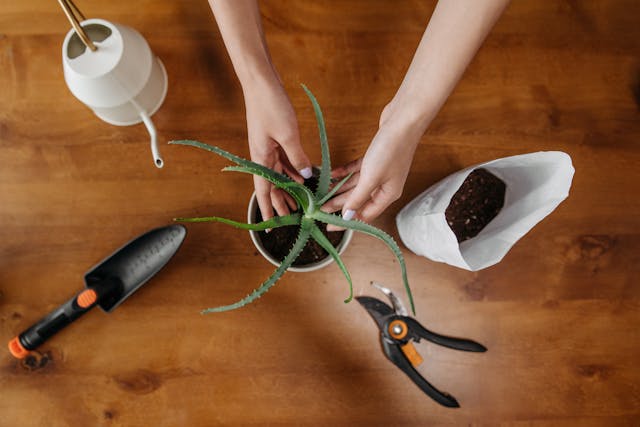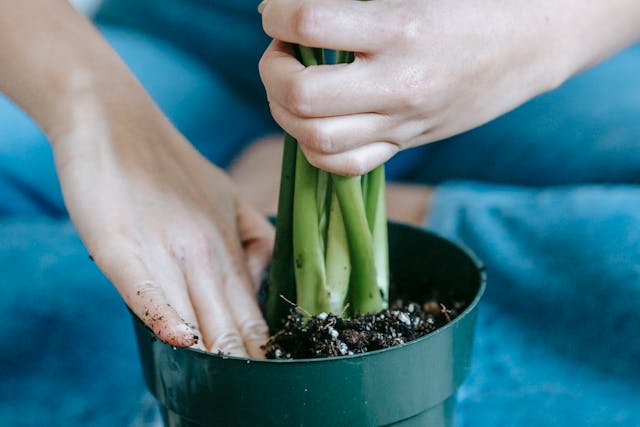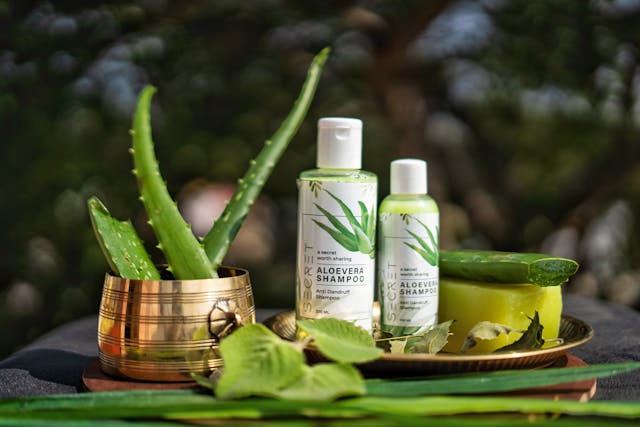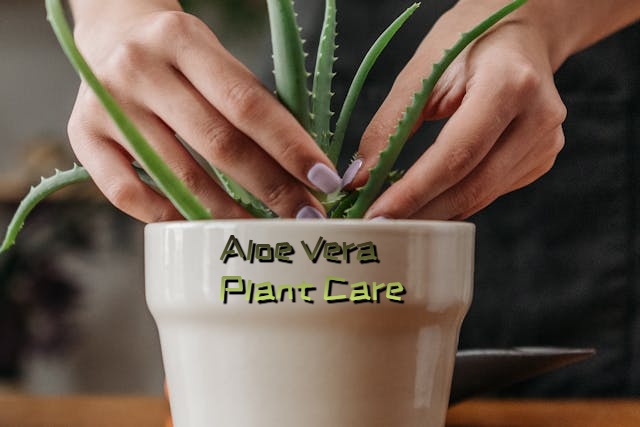Aloe vera is one of the most beloved houseplants around the world, cherished not only for its aesthetic appeal but also for its numerous medicinal and cosmetic benefits. Known for its succulent, fleshy leaves filled with soothing gel, aloe vera requires proper care to thrive. Whether you’re a beginner gardener or a seasoned plant enthusiast, mastering aloe vera plant care is essential to keep your plants healthy and beautiful.
In this comprehensive guide, we’ll dive deep into every aspect of aloe vera plant care. From choosing the right soil to managing pests and propagation, you’ll learn everything needed to ensure your aloe vera plant flourishes. Let’s get started!

🌿 Why Aloe Vera is a Popular Houseplant
Aloe vera plants have surged in popularity due to their low-maintenance nature and impressive versatility. Not only are they easy to care for, but they also bring a touch of nature indoors, purifying the air and adding a calming aesthetic to any room.
Moreover, aloe vera plants are well-known for their medicinal properties. The gel inside their leaves can soothe burns, heal wounds, and even act as a natural moisturizer. With such an array of benefits, it’s no wonder that aloe vera has become a staple in modern homes.
Related Article: Benefits of Aloe Vera Plant in Home
🌍 Understanding Aloe Vera: Origins and Types
Aloe vera plants belong to the succulent family and are native to arid regions, primarily in Africa and the Arabian Peninsula. They are accustomed to hot, dry climates, which greatly influences their care requirements.
🌵 Popular Types of Aloe Vera Plants
- Aloe Vera Barbadensis Miller – The most common variety known for medicinal uses.
- Aloe Aristata (Lace Aloe) – Smaller with white speckles and soft spines.
- Aloe Ferox – Larger, with reddish spines along the leaves.
- Aloe Variegata (Tiger Aloe) – Distinctive striped patterns.
Choosing the right type of aloe vera can greatly affect care requirements, especially in terms of sunlight and watering needs.
🪴 Essential Aloe Vera Plant Care Basics
Taking good care of an aloe vera plant starts with understanding its fundamental needs. Since they are succulents, aloe vera plants store water in their leaves, making them drought-tolerant. However, improper watering and poor soil drainage can harm the plant.
💧 Key Care Essentials
- Light: Bright, indirect sunlight.
- Watering: Infrequent but thorough.
- Soil: Well-draining cactus or succulent mix.
- Temperature: Warm and dry conditions.
By adhering to these basic care principles, you will set a strong foundation for your aloe vera plant’s health and longevity.
🪴 Choosing the Right Pot and Soil for Aloe Vera
Selecting the perfect pot and soil mix is vital for aloe vera plant care. The wrong choices can result in root rot or stunted growth.
🪴 Pot Selection Tips
- Material: Terra cotta or ceramic pots are best for promoting air circulation.
- Drainage Holes: Ensure the pot has at least one hole to prevent water accumulation.
- Size: Choose a pot slightly larger than the root ball.
🌱 Best Soil for Aloe Vera
Aloe vera thrives in well-draining soil. Use a cactus or succulent potting mix that contains sand, perlite, and a small amount of organic matter. Avoid using regular potting soil, as it retains too much moisture.
💦 Proper Watering Techniques for Aloe Vera Plants
Watering is one of the most critical aspects of aloe vera plant care. Overwatering is the number one cause of aloe vera plant death, as it leads to root rot.
🌧️ Watering Frequency
- Summer: Once every two to three weeks.
- Winter: Once every four to six weeks.
- Observation: Water only when the top two inches of soil feel completely dry.
💡 How to Water Properly
- Water deeply and allow excess to drain.
- Never let the plant sit in standing water.
- Use room-temperature water for optimal results.
☀️ Light and Temperature Requirements
Aloe vera plants are sun-loving succulents, but too much direct sunlight can scorch their leaves. Finding the right balance is key to promoting lush, healthy foliage.
🌞 Ideal Lighting Conditions
- Indoors: Place near a south or west-facing window.
- Outdoors: Choose a spot with partial shade.
- Artificial Light: Use grow lights if natural light is insufficient.
🌡️ Temperature Preferences
- Ideal Range: 55°F to 80°F (13°C to 27°C)
- Avoid: Frost and freezing temperatures, as they can damage the plant.
🌿 Fertilizing Aloe Vera for Optimal Growth
Though aloe vera plants do not require heavy fertilization, occasional feeding can boost their vitality.
🌾 Best Fertilizer Types
- Succulent Fertilizer: Diluted to half strength.
- Organic Options: Compost tea or diluted fish emulsion.
🗓️ Fertilizing Schedule
- Spring and Summer: Fertilize once a month.
- Fall and Winter: Reduce or stop fertilization.
🌱 Repotting Aloe Vera: When and How to Do It
Repotting is necessary when your aloe vera plant outgrows its current pot or the soil becomes compacted.
🔁 Signs Your Aloe Needs Repotting
- Roots are visible through the drainage holes.
- Soil drains slowly or smells musty.
- Plant appears top-heavy and tips over.
🪴 Steps to Repot Aloe Vera
- Carefully remove the plant from its pot.
- Shake off excess soil and check for root damage.
- Place in a slightly larger pot with fresh, well-draining soil.
- Water lightly and keep in indirect light for a few days.
Pruning and Trimming Aloe Vera Leaves
Regular pruning and trimming are essential parts of aloe vera plant care, as they help maintain the plant’s shape and remove damaged or diseased leaves. Pruning also encourages healthy new growth and prevents overcrowding.
🪚 When to Prune Your Aloe Vera
- Damaged Leaves: Brown, withered, or moldy leaves should be removed immediately.
- Overcrowded Plants: Trim back if the plant becomes too dense or crowded.
- Propagating Purposes: Take healthy leaves for propagation.
✂️ How to Prune Aloe Vera Properly
- Sterilize Your Tools: Use clean, sharp scissors or a knife.
- Identify Leaves to Trim: Choose damaged or lower, older leaves.
- Cut Close to the Base: Make a clean, straight cut.
- Dispose or Use the Leaves: Utilize the gel or compost the remnants.
By regularly pruning your aloe vera plant, you not only enhance its appearance but also maintain its overall health and vitality.

🦠 Managing Pests and Diseases in Aloe Vera Plants
Although aloe vera plants are relatively resistant to pests and diseases, they are not completely immune. Being proactive about pest control and disease prevention is crucial for maintaining plant health.
🕷️ Common Pests
- Mealybugs: White, cotton-like clusters at the leaf bases.
- Aphids: Small green or black insects feeding on sap.
- Spider Mites: Tiny webs on leaves.
🦠 Frequent Diseases
- Root Rot: Caused by overwatering and poor drainage.
- Leaf Spot: Brown or black spots indicating fungal infection.
- Soft Rot: A bacterial issue causing mushy leaves.
🧴 Treatment and Prevention
- Neem Oil: Spray diluted neem oil to combat pests.
- Natural Insecticidal Soap: Use mild soap solutions to wash affected leaves.
- Good Hygiene: Remove dead leaves and debris regularly to reduce fungal risks.
Maintaining a clean environment and monitoring your aloe vera plant frequently will help keep pests and diseases at bay.
🌱 Propagating Aloe Vera: Step-by-Step Guide
Aloe vera propagation is a fantastic way to expand your collection or share plants with friends. It’s an easy and rewarding process when done correctly.
🌱 Methods of Propagation
- Using Offsets (Pups): The most straightforward and effective method.
- Leaf Cuttings: Less successful but worth trying.
- Seeds: A slower and more challenging process.
🌿 Step-by-Step Propagation with Offsets
- Identify Healthy Pups: Look for young plants near the base.
- Remove Carefully: Gently separate pups from the parent plant with a clean knife.
- Drying Out: Let the cut ends dry for a day to form a callus.
- Replant: Place in well-draining soil and lightly water.
🌵 Leaf Cutting Propagation
- Cut a healthy leaf at the base.
- Allow the cut end to callous for 2-3 days.
- Plant the leaf in moist, well-draining soil.
- Water sparingly until new growth appears.
🌼 Seasonal Care Tips for Aloe Vera Plants
Caring for aloe vera varies slightly depending on the season. Adjusting your routine to suit different conditions ensures year-round vitality.
🌞 Spring and Summer Care
- Watering: Increase frequency, as the plant is actively growing.
- Light: Provide ample sunlight without scorching the leaves.
- Fertilizing: Apply diluted fertilizer every month.
❄️ Fall and Winter Care
- Watering: Reduce to once every 4-6 weeks.
- Temperature: Protect from cold drafts and frost.
- Light: Ensure sufficient indoor lighting.
By adapting your care routine to the seasons, your aloe vera will remain vibrant and healthy throughout the year.
❗ Common Problems and Solutions for Aloe Vera Care
Even with diligent care, aloe vera plants may encounter issues. Understanding the common problems and their solutions will help you address them promptly.
🌿 Problem: Yellowing Leaves
- Cause: Overwatering or poor drainage.
- Solution: Repot in well-draining soil and reduce watering frequency.
🌱 Problem: Leaf Tips Turning Brown
- Cause: Lack of humidity or too much direct sunlight.
- Solution: Move the plant to a location with indirect light and maintain moderate humidity.
🪴 Problem: Drooping or Soft Leaves
- Cause: Excess moisture or root rot.
- Solution: Allow the soil to dry out completely before watering again.
By recognizing early warning signs and acting swiftly, you can save your aloe vera plant from severe damage.

🌟 Benefits of Aloe Vera: Health and Beauty Uses
The gel from aloe vera leaves has been used for centuries for its therapeutic properties. Aloe vera is widely appreciated for its ability to soothe burns, moisturize skin, and promote healing.
💧 Skin and Hair Care
- Burn Relief: Apply fresh gel directly to minor burns.
- Moisturizer: Use as a natural skin hydrator.
- Hair Conditioner: Mix with coconut oil for a nourishing hair mask.
🌿 Health Benefits
- Digestive Aid: Drinking aloe vera juice can help alleviate stomach issues.
- Immune Boosting: Rich in vitamins and antioxidants.
- Anti-inflammatory Properties: Helps reduce skin irritation and inflammation.
Incorporating aloe vera into your daily routine can lead to numerous health benefits, both internally and externally.
🏡 Creative Display Ideas for Aloe Vera Plants
Aloe vera plants aren’t just practical—they’re also stylish! Incorporating them into your decor can add a natural touch to any space.
🌱 Decorative Pots and Containers
- Use vintage ceramic pots or rustic planters to highlight the plant’s unique aesthetic.
- Elevate small aloe vera plants on decorative stands.
🪴 Indoor and Outdoor Arrangements
- Combine aloe vera with other succulents for an eye-catching succulent garden.
- Create a hanging aloe vera planter for small spaces.
Let your creativity shine while showcasing the natural beauty of your aloe vera plants.
🌺 Conclusion: Your Aloe Vera Plant Care Journey
Caring for an aloe vera plant doesn’t have to be daunting. By following these expert tips and maintaining a consistent routine, you can enjoy a thriving, beautiful aloe vera plant year-round. Whether you’re growing for aesthetic purposes or benefiting from its medicinal properties, your efforts will surely be rewarded.
Remember, patience and observation are key to mastering aloe vera plant care. Embrace the journey and watch your plants flourish!

